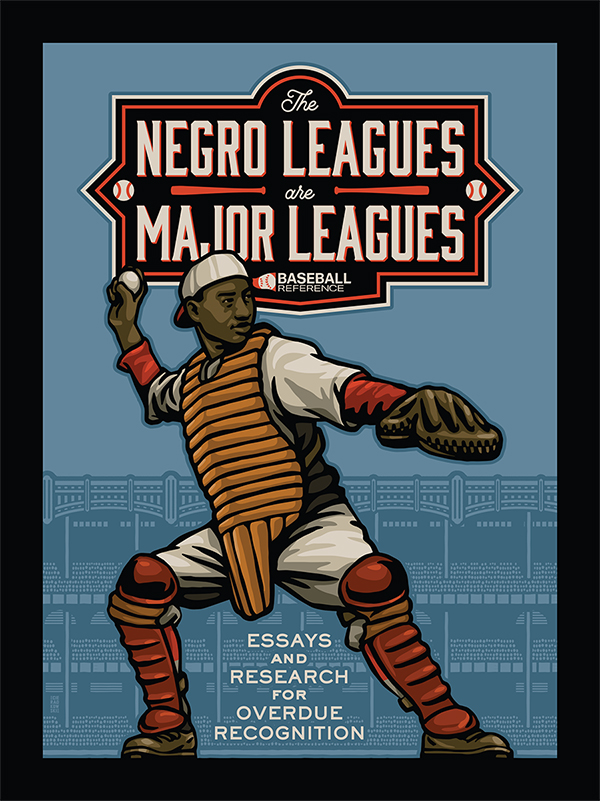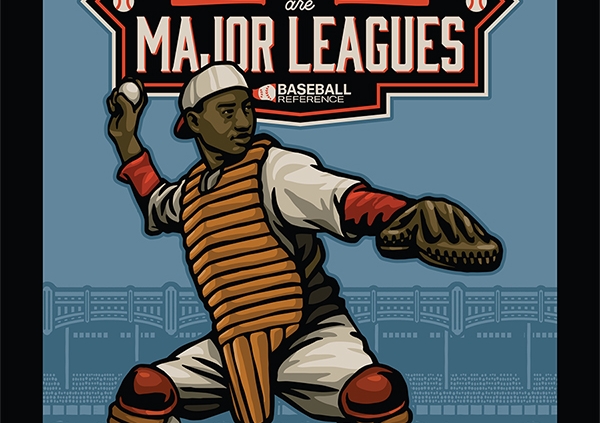Introduction: The Negro Leagues are Major Leagues
This article was written by Sean Forman - Cecilia Tan
This article was published in The Negro Leagues Are Major Leagues
 This book came to be because in 2020 a significant change took place in the way the Negro Leagues were viewed by the mainstream baseball establishment. A movement had been underway for some time at that point, with a vanguard of historians—notably Todd Peterson—making the case that the Negro Leagues were major leagues.
This book came to be because in 2020 a significant change took place in the way the Negro Leagues were viewed by the mainstream baseball establishment. A movement had been underway for some time at that point, with a vanguard of historians—notably Todd Peterson—making the case that the Negro Leagues were major leagues.
The Society for American Baseball Research (SABR) convened a committee on the subject, which quickly concurred with Peterson and identified specific leagues and years that ought to be designated “major.” Before that committee could announce its findings, Major League Baseball itself came independently to the same conclusion. In December 2020, Commissioner of Baseball Robert D. Manfred, Jr. announced a new MLB policy to recognize the Negro Leagues as major leagues.
To reflect the change, Baseball-Reference.com dramatically expanded coverage of the Negro Leagues and historical Black major league players on the site. Major Negro Leagues (from 1920 through 1948) are now listed alongside the National League and American League (and other historical major leagues such as the Federal League). In doing so, Baseball Reference did not bestow a new status on Negro League players or their accomplishments. The Negro Leagues have always been major leagues. Baseball Reference updated the site’s presentation to properly recognize that fact. We would especially direct you to Gary Ashwill’s piece on the building of the Seamheads database. This work forms the basis of the project and is a leap forward in the construction of a statistical record for Black baseball.
- E-book: Click here to download the e-book version of The Negro Leagues are Major Leagues for FREE from the SABR Store. Available in PDF, Kindle/MOBI and EPUB formats.
- Paperback: Get a 50% discount on The Negro Leagues are Major Leagues paperback edition from the SABR Store ($12.95 includes shipping/tax; delivery via Kindle Direct Publishing can take up to 4-6 weeks.)
But the integration and presentation of Negro Leagues stats on the site were not the only update that took place. After all, the game and its players are not just their numbers. We commissioned articles from prominent Negro League historians, family members of Black baseball players, and others to explain the context behind the rise of Black baseball, how it operated, who was involved, and its part in the history of the game. We wanted to contextualize the numbers, and to recognize that the legend and lore of many of these players exist beyond stats.
The Negro Leagues data are not complete. While the quality of play in the Negro Leagues was on a major-league level, the wages, travel, playing conditions, press coverage, and record-keeping were more varied, primarily due to systemic racism. Additionally, Negro League teams played a shorter regular season schedule, but with an extensive amount of exhibitions and barnstorming games that made for seasons that often approached 200 or more games in total. These contests were not part of their league schedule and are therefore not included in this database. This is why Josh Gibson’s Hall of Fame plaque says that he hit “almost 800 home runs” while his page on Baseball-Reference shows 165, and why presenting the numbers in context is a key part of our mission.
The fifteen articles commissioned for the site now comprise the bulk of this book, and are supplemented with some of the significant past works of Negro Leagues history from the SABR archives. In this way we are documenting not only the legacy of the Negro Leagues, but also the effort to rebuild the lost history that led to the current recognition that the Negro Leagues are major leagues.
The Baseball-Reference Essays
- Negro Leagues By The Numbers, by Bob Kendrick, President of the Negro Leagues Baseball Museum, with Joe Posnanski: A look at what the statistics of the Negro Leagues mean.
- Negro Leagues = Major Leagues, by Todd Peterson: An analysis of the quality of play of the Negro Leagues and the White major leagues.
- A Love Story, by Adam Jones, 14-year MLB veteran: What the Negro Leagues mean to a modern Black star.
- The Black Boys of Summer: A statistical observation, by Larry Lester: A look at how the Negro League stats were compiled and the effect on the record books.
- Gibson Family Reflections on the Publication of Baseball Reference’s Negro Leagues Statistics, by Sean Gibson, great-grandson of Josh Gibson: What it means to family members of Negro League stars to see this update.
- Women in the Negro Leagues, by Leslie Heaphy: A discussion of the women who were executives and players the Negro Leagues.
- A Black Baseball Legacy, by Michael E. Lomax: The evolution of Black Baseball from the 19th through the 20th century.
- Turkey Stearnes and the Inclusive Grand Slam, by Vanessa Ivy Rose, granddaughter of Turkey Stearnes: A reflection on the legacy of Hall of Famer Turkey Stearnes.
- Building the Seamheads Negro Leagues Database, by Gary Ashwill: A look at how the data that you see on the site today was collected.
- Historiography of Black Baseball & Negro Baseball Leagues, by Gary Gillette: A timeline of important Black Baseball and Negro League histories and reference works.
- Still Standing: Where to See Extant Negro League Ballparks, by Gary Gillette: A look at which Negro League ballparks are still standing.
- The Long Road to Jackie Robinson: Nineteenth Century Pioneers in Black Ball, by Ryan Swanson: From Charles Douglass (son of Frederick) to Octavius Catto, all the way to Jackie Robinson.
- Latinos in the Negro Leagues, by Adrian Burgos Jr.: The history of Latin stars in the Negro Leagues from Alex Pompez to Luis Tiant.
- The Major Negro Leagues, by Adam Darowski: A look at the seven major Negro Leagues.
The SABR Articles
- The Negro Leagues Revisited, by Jules Tygiel: This 1986 article traces the history of literature and published sources of information about the Negro Leagues, from Sol White’s seminal Official Baseball Guide to Robert Peterson’s Only the Ball was White to John Holway’s Voices from the Great Black Baseball Leagues, and a plethora of oral histories, interviews, and academic studies that followed in the 1970s and 1980s.
- Rube Foster and Black Baseball in Chicago, by Jerry Malloy: Scholar Malloy, the namesake of SABR’s annual Negro Leagues conference, here paints the picture of Chicago’s Rube Foster, the “founding father” of the Negro Leagues, and goes on to detail how after the collapse of the leagues during the Great Depression, the resurgent leagues showcased their talent annually at Comiskey Park in the lavish East-West All-Star Game.
- The Black Press and the Collapse of the Negro League in 1930, by David Hopkins: Tracing the effects of the Great Depression on the Negro National League through the spotty and sometimes contradictory coverage found in the Pittsburgh Courier, the Black weekly newspaper with the largest circulation.
- Black Bluejackets: Great Lakes Negro Varsity team in 1944, by Jerry Malloy: As the Navy began to admit Black sailors to their ranks, they likewise admitted them to sports programs and teams that were important public relations and morale-building tools. The Great Lakes “Negro Varsity” would field numerous Negro League stars and pave the way for the eventual integration of baseball.
- Pitching Behind the Color Line—Baseball, Advertising, and Race, by Roberta Newman: A look at representations of African Americans and baseball imagery in advertising in the 1930s and 1940s, in the Black weeklies, local newspapers, and, eventually, television.
- Umpires in the Negro Leagues, by Leslie Heaphy: The history of umpires in the Negro Leagues, from the practice of using White umpires to pioneering Black umpires like Bob Motley and Julian Osibee Jelks.
- Quebec Loop Broke Color Line in 1935, by Merritt Clifton: Eleven years before Jackie Robinson integrated the Montreal Royals en route to the Brooklyn Dodgers, a pitcher-outfielder named Alfred Wilson joined the Granby Red Sox of the Quebec Provincial League, an unaffiliated independent league.
- The Double Victory Campaign and the Campaign to Integrate Baseball, by Duke Goldman: The two victories sought by the Double V campaign were to defeat Nazism abroad and racism at home. Launched by The Courier, the largest of the Black newspapers in the US, the campaign would ultimately score two victories: the desegregation of baseball and the US military.
It is important to remember that the history of Black baseball does not start in 1920 or end in 1948 and even from 1920-1948 our presentation is incomplete. There were hundreds of teams and thousands of players that would need to be included to make up a more complete and richer history of Black baseball. From 1920 though 1948 there were many star players and teams that found it more feasible to play a barnstorming schedule (not only in the United States, but also the Caribbean, Mexico, and Venezuela) rather than participate in leagues. These independent teams were often the equal of teams we are including as major league teams on the site now. The Baseball Reference complete register of baseball history contains a significant record of Independent and non-major Negro Leagues. For example, we have a page for the 1917 Chicago American Giants. Research on both the Negro Leagues and independent teams does not end here; this is but another step in the process.
Finally, we express our respect to the thousands of men and women who were involved in the Negro Leagues, with heartfelt acknowledgement to the very few who are still alive. Likewise, we express our respect to their descendants who keep the stories of their forebears alive—their struggles and also their accomplishments, not only on the field, but also off the field. We encourage our readers to seek out and support the likes of foundations and causes supported by the families of Satchel Paige, Josh Gibson, Buck Leonard, and others.
SEAN FORMAN launched Baseball Reference in the Spring of 2000 while avoiding his Ph.D. dissertation at the University of Iowa. He eventually completed his dissertation in Applied Mathematics and taught math and computer science for six years at Saint Joseph’s University in Philadelphia. In the fall of 2007, Sports Reference LLC was formed, combining baseball, basketball, and football sites, and has now grown to twenty eight employees and includes college sports, hockey, and world football. Sean was named a Henry Chadwick Award winner in 2011, 2020 SABR Analytics Conference Lifetime Achievement Award winner and continues to serve as Sports Reference’s President. Sports Reference has been named a top 50 site by Time Magazine, won a Sloan Conference Alpha Award in 2013, and is the current statistical partner for the National Baseball Hall of Fame.
CECILIA M. TAN has been writing about baseball since a fourth grade book report about Reggie Jackson. She has written for Yankees Magazine, Baseball Prospectus, and Gotham Baseball. Her editing skills have been applied to many baseball publications ranging from the 2012-2013 Baseball Prospectus Annuals to the Baseball Research Journal. She has been Publications Director for SABR since 2011.


